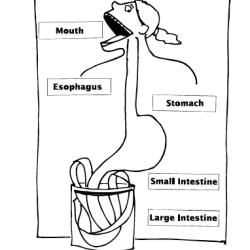Source Institutions
Source Institutions
Add to list Go to activity
Activity link broken? See if it's at the internet archive

In this "gross" activity (on pages 34-46), learners make a life-size model of a human digestive tract, and follow the life of a beef tapeworm as it makes its way through. In Part One, learners color, cut out, and assemble the parts of the digestive system, including full-length small and large intestines. In Part Two, learners cut out pictures of the stages of tapeworm development, and tape them within the model. A beef tapeworm life cycle diagram helps put the human host period within a larger system.
- 30 to 45 minutes
- 45 to 60 minutes
- 1 cent - $1 per group of students
- Ages 8 - 14
- Activity, Model
- English, Spanish
Quick Guide
Materials List (per group of students)
- stapler (1-2 for teams to share)
- 1 large poster board
- blue and red pencils or crayons
- 1 large plastic bag
- meter stick
- 1 pair of scissors per person
- glue or glue stick
- tape
- 1 copy of Mouth and Esophagus (p.36) on white paper
- 1 copy of Stomach (p.37) on pink paper
- 6 copies of Small Intestine (p.38) on pink paper
- 2 copies of the Large Intestine (p.39) on pink paper
Subjects
-
Life Sciences
-
Diversity of Life
- Animals
-
Ecology
- Ecosystems
-
Human Body
- Digestion
- Health and Nutrition
-
Diversity of Life
Audience
To use this activity, learners need to:
- see
- see color
- read
Learning styles supported:
- Involves teamwork and communication skills
- Uses STEM to solve real-world problems
- Involves hands-on or lab activities
Designed specifically for
- Rural dweller
Culture, ethnicity, and gender
-
Girls
- Explicity developed for this group
Other
Foreign language versions of this resource:
Components that are part of this resource:
Includes alignment to state and/or national standards:
This resource is part of:
Access Rights:
- Free access
By:
Source Collection
- Science After School Consumer's Guide
Rights:
- All rights reserved, University of Nebraska State Museum, 2001
Funding Sources:
- NSF Informal Science Education Program, 9909496
- Howard Hughes Medical Institute
